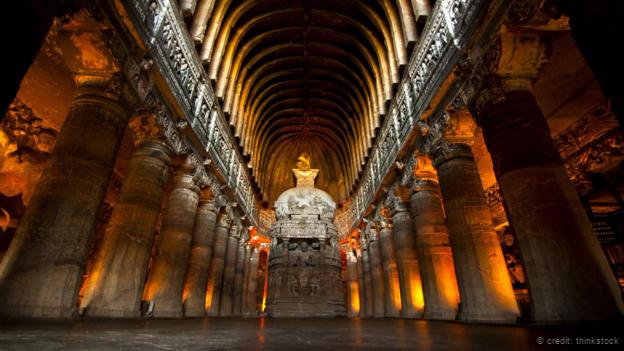When it comes to ancient wonders, there’s more to explore than Petra, Angkor Wat and the Coliseum. So to uncover a few structures that aren’t typically on the tourist trail, we turned to question-and-answer site Quora, where users have been sharing their opinions on some of the most impressive ancient structures in the world. What made the list? Among others: a network of ancient Micronesian floating islands, an underground Anatolian city carved entirely of volcanic rock and a prehistoric Phoenician site comprised of monumental stone blocks so large, it remains a mystery how they were cut and moved.
Derinkuyu, Turkey
Underneath the small town of Derinkuyu, 750km southeast of Istanbul in Cappadocia’s Nevsehir province, lies the largest system of caverns ever built by hand – Derinkuyu – Turkey’s underground city, which shares a name with its more conventional, above-ground counterpart.
This ancient Anatolian wonder has all the trappings of a well-developed municipal centre, with schools, stables and churches – but rather than rising from the ground, Derinkuyu’s meeting places are carved from soft volcanic rock 60m to 85m beneath the surface.
Built between the 7th and 8th Century BC, the underground complex was built to defend against attacks from marauding armies. Though it was intended as a temporary shelter, its amenities were impressive: some 600 above-ground doors from which someone can enter the underground city from, 15,000 ventilation ducts to provide fresh air, as well as multiple wineries, cellars and a complex network of passages, tunnels, and corridors.
"It was large enough to shelter around 20,000 people with their livestock and food stores,” Quora user Trishla Prasad wrote.
Considering its age, the underground city is in excellent condition and is accessible today via numerous tours. Travellers should be advised, however, that exploring the complex involves a lot of stairs.
Nan Madol, Federated States of Micronesia
Built around 1200, the mysterious floating Micronesian city of Nan Madol comprises a series of man-made basalt islets separated by a network of canals. Located on Pohnpei, more than 3,600km east of the Philippines in the middle of the Pacific Ocean, it’s no surprise that the site is fairly unknown.
"[Nan Madol] was apparently the residential complex of the island elite and each islet served a specific purpose, such as canoe building, cooking, caring for the sick, and was probably roofed over with timber and palm thatch,” said Terry Newman, who has visited the site twice. "It is a crude and primitive Angkor Wat overgrown by the jungle, but no less mind blowing in a place with no history of permanent structures, let alone architecture.”
Baalbek, Lebanon
Located in eastern Lebanon’s Beqaa Valley, the well-preserved ancient site of Baalbek was settled some 9,000 years ago, eventually attracting a series of ancient peoples, including Phoenicians, Greeks and Romans. It was used primarily as a religious site, with monumental temples devoted to gods such as Bacchus, Venus and Jupiter.
"The Temple of Bacchus alone is bigger than the Parthenon in Greece,” wrote Quora user Ella Ryan. "The neighbouring Temple of Jupiter has only five of its 54 Corinthian columns still standing, but at 22m tall and two metres in girth, they are jaw-droppingly enormous and are said to be the largest in the world.”
At the foundation of Jupiter's temple is a trio of megaliths, some of the biggest individual building blocks in the world. How each block was cut and moved into place is still somewhat of a mystery, but some say they were positioned into place by Roman cranes (primitive devices consisting of a winch, a rope and a block with pulleys).
Newgrange, County Meath, Ireland
Newgrange’s massive, rounded dome rises from the emerald plains of Ireland’s County Meath like a grass-topped UFO. Constructed more than 5,000 years ago, during the Neolithic period around 3,200BC, this ancient site is storied in Irish folklore and considered one of the most important megalithic structures in Europe.
The structure itself is a huge grass-topped mound made of alternate layers of earth and stone. At 76m across, 12m high and covering 4,500sqm of ground, the Unesco World Heritage site is ringed with a facade of white quartz stone, added during a reconstruction in the 1970s. Inside is a chambered passage that stretches for 19m, ending with three small chambers thought to be ancient burial sites.
This ancient structure's secret: it's a remarkably accurate time-telling device, wrote Elle Land. The structure is aligned with the rising sun and its chambers are flooded with light during the Northern Hemisphere’s winter solstice (occurring on 21 December this year). "As the sun rises higher… the whole room becomes dramatically illuminated,” Land said. "The intent of its builders was undoubtedly to mark the beginning of the New Year.”
Ajanta and Ellora Caves, Maharashtra, India
About 30km northwest from the city of Aurangabad, India’s Ellora Caves are considered the pinnacle of Indian rock-cut architecture. The site’s 34 caves were carved from the stone face of the Charanandri hills between the 6th and 9th Century.
The caves are most valued for their ancient paintings and sculptures, considered masterpieces of Buddhist art that are considered the beginning of classical Indian art. The Archaeological Survey of India calls them "the finest surviving examples of Indian art, particularly painting”. The Ellora site is also home to the impressive Kailasa Temple, which is carved from a single rock. "Its sheer size and architectural finesse completely stuns anyone,” said Hamid Shah.
About 100km northeast are the Ajanta Caves, a spectacle dubbed "one of the great wonders of the ancient world” by British historian William Dalrymple. The formidable caverns were cut into cliffs between the 2nd and 7th Century to house Buddhist temples, shrines, prayer halls and dormitories.
"Over the years, due to time and negligence, most of [the cave’s] mural paintings have peeled off but you can see its former glory from the ones which have survived and been preserved,” Shah wrote. "It is still a beauty even after 1,500 years.”
(BBC)








www.ann.az
Follow us !











